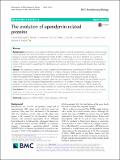Files in this item
The evolution of ependymin-related proteins
Item metadata
| dc.contributor.author | McDougall, Carmel | |
| dc.contributor.author | Hammond, Michael | |
| dc.contributor.author | Dailey, Simon C. | |
| dc.contributor.author | Somorjai, Ildiko M. L. | |
| dc.contributor.author | Cummins, Scott | |
| dc.contributor.author | Degnan, Bernard | |
| dc.date.accessioned | 2018-12-04T16:30:10Z | |
| dc.date.available | 2018-12-04T16:30:10Z | |
| dc.date.issued | 2018-12-04 | |
| dc.identifier | 250513259 | |
| dc.identifier | e56bf9b5-efb7-427c-85b2-00fae1e07cdf | |
| dc.identifier | 85057982178 | |
| dc.identifier | 000452119500002 | |
| dc.identifier.citation | McDougall , C , Hammond , M , Dailey , S C , Somorjai , I M L , Cummins , S & Degnan , B 2018 , ' The evolution of ependymin-related proteins ' , BMC Evolutionary Biology , vol. 18 , 182 . https://doi.org/10.1186/s12862-018-1306-y | en |
| dc.identifier.issn | 1471-2148 | |
| dc.identifier.other | ORCID: /0000-0001-5243-6664/work/51470230 | |
| dc.identifier.uri | https://hdl.handle.net/10023/16626 | |
| dc.description | This research was funded by Australian Research Council grants to BMD and SFC (DP130102543). IMLS gratefully acknowledges start-up funding for her lab from MASTS (Marine Alliance for Science and Technology Scotland) and seedcorn funding through the Wellcome Trust ISSF3 grant number 204821/Z/16/Z. | en |
| dc.description.abstract | Background: Ependymins were originally defined as fish-specific secreted glycoproteins involved in central nervous system plasticity and memory formation. Subsequent research revealed that these proteins represent a fish-specific lineage of a larger ependymin-related protein family (EPDRs). EPDRs have now been identified in a number of bilaterian animals and have been implicated in diverse non-neural functions. The recent discoveries of putative EPDRs in unicellular holozoans and an expanded EPDR family with potential roles in conspecific communication in crown-of-thorns starfish suggest that the distribution and diversity of EPDRs is significantly broader than currently understood. Results :We undertook a systematic survey to determine the distribution and evolution of EPDRs in eukaryotes. In addition to Bilateria, EPDR genes were identified in Cnidaria, Placozoa, Porifera, Choanoflagellatea, Filasterea, Apusozoa, Amoebozoa, Charophyta and Percolozoa, and tentatively in Cercozoa and the orphan group Malawimonadidae. EPDRs appear to be absent from prokaryotes and many eukaryote groups including ecdysozoans, fungi, stramenopiles, alveolates, haptistans and cryptistans. The EPDR family can be divided into two major clades and has undergone lineage-specific expansions in a number of metazoan lineages, including in poriferans, molluscs and cephalochordates. Variation in a core set of conserved residues in EPDRs reveals the presence of three distinct protein types; however, 3D modelling predicts overall protein structures to be similar. Conclusions: Our results reveal an early eukaryotic origin of the EPDR gene family and a dynamic pattern of gene duplication and gene loss in animals. This research provides a phylogenetic framework for the analysis of the functional evolution of this gene family. | |
| dc.format.extent | 13 | |
| dc.format.extent | 4283907 | |
| dc.language.iso | eng | |
| dc.relation.ispartof | BMC Evolutionary Biology | en |
| dc.subject | Ependymin | en |
| dc.subject | EPDRs | en |
| dc.subject | MERPs | en |
| dc.subject | Gene duplication | en |
| dc.subject | Gene loss | en |
| dc.subject | QH301 Biology | en |
| dc.subject | DAS | en |
| dc.subject.lcc | QH301 | en |
| dc.title | The evolution of ependymin-related proteins | en |
| dc.type | Journal article | en |
| dc.contributor.sponsor | The Wellcome Trust | en |
| dc.contributor.institution | University of St Andrews. School of Biology | en |
| dc.contributor.institution | University of St Andrews. Biomedical Sciences Research Complex | en |
| dc.contributor.institution | University of St Andrews. Marine Alliance for Science & Technology Scotland | en |
| dc.contributor.institution | University of St Andrews. Scottish Oceans Institute | en |
| dc.identifier.doi | 10.1186/s12862-018-1306-y | |
| dc.description.status | Peer reviewed | en |
| dc.identifier.grantnumber | 204821/Z/16/Z | en |
This item appears in the following Collection(s)
Items in the St Andrews Research Repository are protected by copyright, with all rights reserved, unless otherwise indicated.

